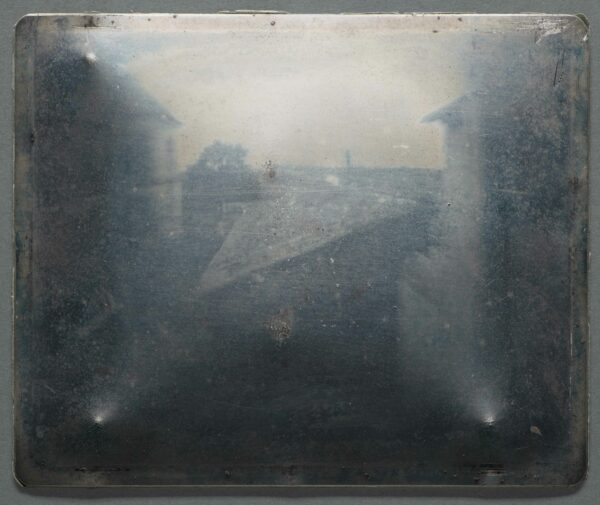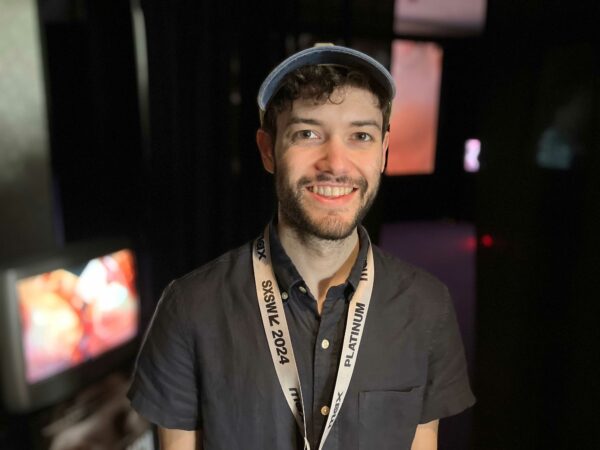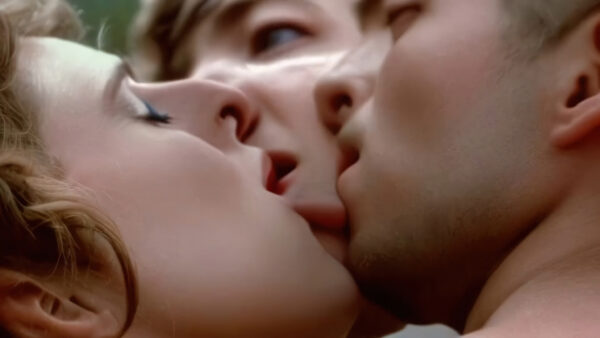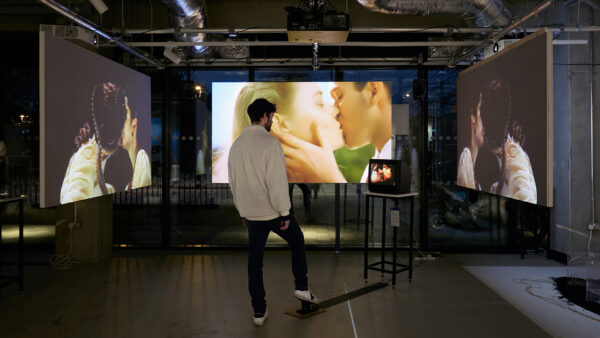With lineups that regularly include former presidents, Oscar winners, and stars like Lizzo and Willie Nelson, Austin’s South by Southwest festival has grown into one of the premier international venues for music and film since its inauguration in 1987. In recent years, the festival has expanded to include a focus on visual arts and other forms of new media, with the 2024 line-up including a panel on “Salvador Dali, AI, and The Future of Creativity,” an exhibition of “fine poster art,” several artist documentaries, and a selection of interactive XR installations.
Artist Adam Cole, a New York native currently based in London, was on hand at this year’s festival to present KISS/CRASH, an installation triptych that “employs AI imagery to explore themes of desire and the expanding gap between real experience and artificial representations in the digital age.” I had the opportunity to speak with Cole, whose installation won the SXSW Audience Award for XR Experience Special Event, to discuss the influence of Cindy Sherman and Dada, creating art with interactive elements, anxieties around the future of AI, and the throughline that runs from AI art to the Niépce Heliograph, history’s oldest surviving photograph.
Michael Flanagan (MF): AI is a relatively new medium for artists. How did you come to begin incorporating it into your work?
Adam Cole (AC): My background was always in film. Maybe not always as a creator, but it was always sort of my love. I got my start during my undergraduate studies in Digital Media Design. It was half computer science and half fine arts and with a real focus on the tools that power computer animation. So it was quite technical in its focus. But then the electives I was able to take — whenever I was able to take them — were always in cinema studies and fine arts.
I ended up in a career that was more technical focused but decided to go back to school for a degree in the UK in a program called Creative Computing. That degree was focused on merging technical skills with creative production and basically any art that’s focused on code or robotics, or now AI. It was a great place to hone my skills, and bring in that critical element to using these tools. For me, what tied it all together was bringing it into this tradition of cinema and connecting these tools to the history of images
MF: You’re exploring some big ideas in KISS/CRASH — things like identity, complicity, desire, fantasy, and appropriation. I noticed that the central projection features the image of a 1959 Chevy Bel Air colliding with a 2009 Chevy Malibu, perhaps suggestive of the clashing of past and present modes of thinking. How does your use of classical Hollywood imagery, religious idols, and political celebrities tie into these themes?
AC: I think the work is drawing on so many symbols that are so prevalent from our visual history — the automobile being one of the most significant ones — but intersecting them from different time periods, different styles, different genres, and that splicing effect is so natural for AI, it’s one of the things the medium is most capable of. But it has this sort of schizophrenic effect of not being able to keep up with what it’s saying. It’s this constant change of styles that has this weird effect. All three of these works in the room together play with that changing rhythm of constant morphing and transformation. The real motivation for the work was born out of this anxiety around AI. I saw these image-generating technologies and I was just like, “Where do we go from here? How does art move if we can generate any image and any idea in an instant?”
MF: And what conclusions have you come to?
AC: I reached this point of understanding that we talk about this technology like it’s so radically new like it came from nowhere. You know that we don’t even quite understand its origins. But really, we’ve been drowning in artificial images for 100 years, if not longer. I mean, this is not a completely new concept. And so, the strategies we’ve used to handle that in modernity are the same strategies that artists have always used to manage it, which is to appropriate these image-making technologies and repurpose them for more interesting and explorative artifacts. Artists have done that, from the Dadaists using it in photo montage to pop artists like Andy Warhol to postmodern artists like Cindy Sherman. These are all people who took the predominant marketing, advertising, or film images of their cultural context and just by recontextualizing them, made them much more interesting, much more reflective, and much more poetic. When I think of my own work, it’s a lot about that contextualization and the understanding of where it fits in the history of visual culture, and projecting what it might look like as it accelerates forward.
MF: One of the components of the installation triptych, Crash Me, Gently, incorporates an interactive foot pedal which allows the viewer to control an image of you being shown on a small vintage television. Can you talk about this interactive element?
AC: When you accelerate the foot pedal, it accelerates the kiss on that TV. It starts quite calm, but as you accelerate, it starts to become more intensely cinematic. But then it gets quite aggressive, verging on pornographic and violent. The interactive element adds this complicity to the viewer in this hunt for more extreme content. Because I think that’s a feeling we’ve all experienced in this digital landscape. This question exists: now that we have these AI models, what does it mean that we can see any image that we desire, and how does that affect our fantasies, now that there are no limits to what we can see? I found that interactive element really useful in making it not just a spectacle, and not just voyeuristic experience, but also an active experience.
MF: The two side panels in the triptych feature a piece called Me Kissing Me. It reads like a self-portrait in AI. Was that the intention?
AC: I think it’s definitely a self-portrait. Me Kissing Me, is a video of me kissing myself that becomes augmented by these AI layers. For me, it’s about the way we project ourselves into these images, into these fantasies. Specifically from cinema, but really from anywhere that our media-saturated world puts up images, which is almost everywhere. And it’s about a certain loneliness that comes from that experience. I mean, I was a gay kid growing up in New York and watching a lot of these Hollywood romances, and they’re quite fabulous, but they also can leave you quite isolated if you don’t fit into those images. The truth is, nobody fits into those images, not just gay people, but, you know, even the actors themselves can’t live up to their images at 30 ft on a projected screen. Me Kissing Me is playing with the way we see ourselves in those images, and the glamor of it, but also the ways that that can inhibit intimacy and communication, and twist and conform our desires in strange and sometimes poetic, but sometimes grotesque ways.
MF: I think it’s fascinating that we’re speaking now in downtown Austin, just a few miles away from the Harry Ransom Center, which houses the Niépce Heliograph, history’s oldest surviving photograph which was produced in 1827. The technology used to produce that photograph was radical. What kind of relationship do you see between that and the work you’re doing?
AC: People talk about AI art like, “Oh, AI art is going to kill artists.” Then, in order to help folks relax their anxiety will say, “Oh, photography came around and that didn’t kill painting. It actually made painting way richer.” Which I think is a fine point to make, but what I find so wild is that people seem so ignorant as to how drastically photography changed everything beyond art, and how it totally transformed our very relationship to reality and upended everything. To so casually say, “Oh well, photography was fine, it didn’t kill painting,” but it kills so much else and it reinvented so much else, so if we really use that as the metaphor we should be incredibly anxious about AI if it’s about to be such a change in our relationship to reality. I find that just kind of funny when people use that metaphor as a way to say, “Oh, it’s actually fine.”

Joseph Nicéphore Niépce, Untitled ‘point de vue,’ 1827, Heliograph on pewter. Photo: Harry Ransom Center
MF: It seems like almost every week there is a new major technological development. How does that affect you as an artist and where do you see yourself taking the kind of work you’re doing?
AC: I think something I learned from this project is that you can’t keep up with the technology. To get into a festival, to get into a show, takes a few months to build the installation. By the time you’re there, there’s some new technology that’s maybe better. So what I’ve learned is that at some point you need to keep up with what’s happening, but you need to choose the technologies you’re going to use for your project and then give it the attention it deserves to really make something interesting. If you’re always just chasing the newest thing, you’re never going to have that time and that space to really invest in it, and do something interesting. I think there will always be new developments with AI video. I think certain things are going to stay the same with AI models, and that’s in the way that they’re trained and the way they generate images. My theory, one that’s present in this work and that I think will be proven true, is that these image-generating technologies are going to inherit much of the cultural conformity, formulas, and myths that already exist in our visual language. They’re going to perpetuate those in really strange and dangerous ways that are going to be quite sterile and clichéd, but also pervasive. I think it’s our job as artists to find ways to expose those biases and limitations, but also find ways to use those technologies that elevate them in some way, to find ways to explore poetry and find something more sublime using these tools.
Learn more about Adam Cole at adamcole.studio and experience KISS/CRASH in digital space at kiss-crash.com.
This interview was edited for length and clarity





